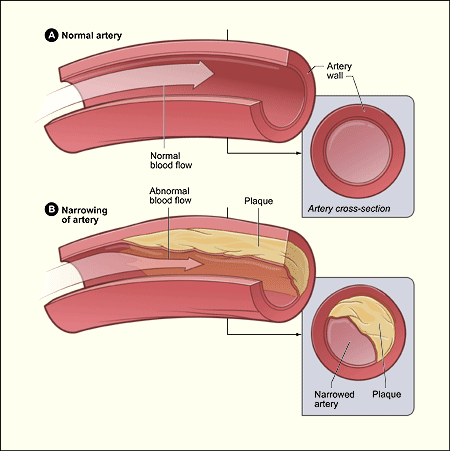
Carotid stenosis refers to the narrowing or constriction of the carotid arteries, which are the major blood vessels located on each side of the neck that supply blood to the brain, face, and neck. This narrowing typically occurs due to the buildup of plaque (atherosclerosis) on the inner walls of the arteries, restricting blood flow to the brain. Carotid stenosis is a significant risk factor for stroke, as it can lead to the formation of blood clots that may travel to the brain and cause a blockage in a cerebral artery, resulting in a stroke.
Causes
- Atherosclerosis: The primary cause of carotid stenosis is the buildup of plaque within the carotid arteries. Plaque consists of fatty deposits, cholesterol, calcium, and other substances that accumulate on the inner walls of the arteries over time.
- Risk factors: Various factors increase the risk of developing carotid stenosis, including:
- High blood pressure
- High cholesterol levels
- Diabetes
- Smoking
- Obesity
- Sedentary lifestyle
- Family history of cardiovascular disease
- Other conditions: Certain medical conditions, such as autoimmune diseases, radiation therapy to the neck, and certain genetic disorders, may also contribute to the development of carotid stenosis.
Symptoms
- Carotid stenosis often does not cause symptoms until it becomes severe and significantly reduces blood flow to the brain. However, symptoms may include:
- Transient ischemic attacks (TIAs): Brief episodes of neurological symptoms, such as weakness, numbness, or difficulty speaking, which resolve within 24 hours.
- Stroke: Sudden onset of neurological symptoms, such as weakness or paralysis on one side of the body, difficulty speaking or understanding speech, vision changes, and severe headache.
- In some cases, carotid bruits (abnormal sounds heard with a stethoscope placed over the carotid arteries) may be detected during a physical examination, but they do not always indicate significant carotid stenosis.
Diagnosis
- Carotid ultrasound: This non-invasive imaging test uses sound waves to visualize the carotid arteries and assess blood flow, plaque buildup, and the degree of stenosis.
- Doppler ultrasound: This imaging test combines traditional ultrasound with Doppler technology to measure blood flow velocity and detect areas of stenosis.
- CT angiography (CTA) or magnetic resonance angiography (MRA): These imaging tests use contrast dye and advanced imaging techniques to provide detailed images of the carotid arteries and assess the degree of stenosis.
Treatment
- Lifestyle modifications: Adopting a heart-healthy diet, quitting smoking, managing high blood pressure and cholesterol levels, maintaining a healthy weight, and getting regular exercise can help slow the progression of carotid stenosis and reduce the risk of complications.
- Medications: Medications such as antiplatelet agents (e.g., aspirin, clopidogrel) and statins may be prescribed to reduce the risk of blood clots and lower cholesterol levels.
- Carotid endarterectomy: This surgical procedure involves removing plaque from the inner walls of the carotid artery to restore blood flow to the brain.
- Carotid artery stenting: This minimally invasive procedure involves inserting a stent (a small mesh tube) into the narrowed carotid artery to open the blockage and improve blood flow.
Prevention
- Managing risk factors: Taking steps to control high blood pressure, high cholesterol, diabetes, and other risk factors can help prevent or slow the progression of carotid stenosis.
- Regular medical check-ups: Monitoring blood pressure, cholesterol levels, and other cardiovascular risk factors through regular medical check-ups can help detect and manage carotid stenosis early.
